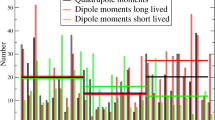Summary
The hyperfine contribution to the magnetic field at the μ+ site is calculated in the elementary dielectric-constant theory, which reveals to be suitable for simple metals, especially in the low-electron-density range. The model is compared with latest experimental data with better agreement than any previous theory, but still not in a completely satisfactory way. Other contributions to the μ+ precession frequency shift are discussed.
Riassunto
È stato calcolato il contributo iperfine al campo magnetico nel posto occupato dal μ+, nell’ambito della teoria elementare della costante dielettrica, che si rivela appropriata per i metalli semplici, specialmente nell’intervallo di basse densità elettroniche. Si è confrontato questo modello con i più recenti dati sperimentali, ottenendo un accordo migliore di quello di tutte le precedenti teorie, ma ancora non del tutto soddisfacente. Si sono disenssi altri possibili contributi allo spostamento della frequenza di precessione del μ+.
Резюме
Вычисляется сверхтонкий вклад в магнитное поле в местонахождении gm+ в рамках элементарной теории диэлектрической постоянной, которая оказывается подходяшей для простых металлов, особенно в области низкой электронной плотности. Эта модель сравнивается с последними экспериментальными данными. Получается более удовлетворительное согласие, чем все предыдущие теории. Обсуждаются другие вклады в сдвиг частоты прецессии μ+.
Similar content being viewed by others
References
M. Camani, F. N. Gygax, E. Klempt, W. Ruegg, A. Schenck, U. Shilling, R. Schulze andH. Wolf:Phys. Rev. Lett.,42, 679 (1979).
P. Jena, K. S. Singwi andR. M. Nieminen:Phys. Rev. B,17, 301 (1978).
P. Jena andK. S. Singwi:Phys. Rev. B,17, 3518 (1978).
P. F. Meier: preprint (1978).
J. Keller andA. Schenck: inProceedings of the First International Topical Meeting on Positive Muon Spin Rotation, Rorschach, Switzerland, 1978, edited byF. N. Gigax, W. Kündig andP. F. Meier (Amsterdam, 1979).
A. Schenck:Exotic atoms, inFirst Course of the International School of Exotic Atoms, Erice, 1977.
J. M. Ziman:Principles of the Theory of Solids (Cambridge, 1965).
L. Landau:Z. Phys.,64, 629 (1930).
F. Kaeck:Phys. Rev.,175, 897 (1968).
D. P. Hutchinson, J. Menes, G. Shapiro andA. M. Patlach:Phys. Rev.,131 1351 (1963). The knight shift values given in this work were all obtained as a byproduct of precision measurement of the muon magnetic moment and are not completely reliable.
D. N. Zubarev:Sov. Phys. Usp.,3, 320 (1960).
Author information
Authors and Affiliations
Additional information
Перевебено ребакцией.
Rights and permissions
About this article
Cite this article
De Renzi, R., Dallacasa, V. Muonic knight shift for simple metals in a linear-response model. Nuov Cim B 61, 353–360 (1981). https://doi.org/10.1007/BF02721336
Received:
Published:
Issue Date:
DOI: https://doi.org/10.1007/BF02721336



